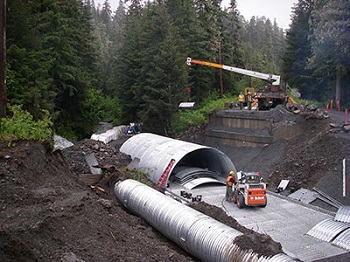Improve Your Building With Culvert Installment: Leading Strategies
When it comes to boosting the performance and value of your property, culvert setup can be a vital yet commonly forgotten aspect. In this conversation, we will check out the key strategies for successful culvert installation, from picking the best type to ensuring proper sizing and upkeep.
Advantages of Culvert Setup
Culverts are essential components of water management systems, allowing the secure passage of water underneath roadways, railways, or tracks. By directing water away from structures and roads, culverts aid stop erosion and damages created by excess water buildup during heavy rainfall or snowmelt.
One considerable advantage of culvert installation is the reduction of flooding threats. Effectively installed culverts help take care of water levels, routing excess water far from vital locations and avoiding prospective damage to framework and buildings. Furthermore, culverts add to preserving the natural environment by preserving the all-natural circulation of streams and rivers. By helping with the activity of water, culverts support aquatic environments and aid receive biodiversity in numerous settings. In general, the installation of culverts is a cost-effective and sustainable service for taking care of water circulation and stopping flooding in both city and country setups.
Picking the Right Culvert Type
Choosing the appropriate culvert type is a vital choice in guaranteeing effective water administration and facilities durability. Various variables should be taken into consideration when picking the ideal culvert type for a specific site. One necessary variable is the material of the culvert. Culverts are frequently made from products like concrete, corrugated metal, plastic, or galvanized steel. The choice of product should be based on the anticipated flow quantity, dirt kind, environmental conditions, and budget restraints.
Another essential factor to consider is the sizes and shape of the culvert. Culverts are available in different forms, consisting of round, elliptical, box, or arc culverts. The shape and dimension of the culvert should straighten with the awaited circulation qualities and the site's topography to ensure optimal water flow and architectural honesty.
Furthermore, the installation approach and maintenance requirements need to likewise influence the decision-making process. Some culvert kinds might be much easier to set up and keep than others, depending on factors such as accessibility, called for equipment, and durability.

Appropriate Sizing for Reliable Water Drainage
Reliable water drainage in culvert installation hinges on the correct sizing of the culvert to match the expected flow characteristics and site topography. The culvert's size or measurements straight influence its capacity to take care of water flow successfully - Underbrush Clearing. When establishing the ideal size for a culvert, variables such as the top flow rate, water quantity, and speed has to be carefully thought about to stop flooding and erosion

To ensure reliable water drainage, it is essential to seek advice from with designers or specialists experienced in hydraulic design (Underbrush Clearing). They can evaluate the certain website requirements and recommend the most appropriate culvert size to advertise proper water flow and stop prospective problems. By purchasing the correct culvert size upfront, home owners can minimize future water drainage problems and secure their infrastructure
Specialist Installation Tips
For optimal culvert setup results, expert competence is important to guarantee accuracy and adherence to market criteria. When it comes to culvert installation, employing skilled experts is crucial for an effective job. Experts have the expertise and abilities to examine the site successfully, identify the appropriate culvert size and material, and set up the culvert complying with ideal techniques.

In addition, using high-quality materials and tools is essential for a long lasting culvert installment. Experts must select culverts made from long lasting materials such as galvanized steel or concrete, making sure long life and marginal maintenance needs. By following these professional installment pointers, homeowner can improve their drain systems properly and sustainably.
Upkeep and Long Life Elements
Guaranteeing appropriate upkeep techniques and thinking about durability variables are critical facets of culvert installment that add substantially to the performance and toughness of the drainage system. Routine maintenance is important to keep culverts devoid of debris accumulation, clogging, and structural damages. Evaluating culverts for any type of indications of wear, disintegration, or clogs must be done periodically to address issues immediately and protect against pricey repair work or substitutes.
Longevity elements such as the material quality of the culvert, proper sizing, and proper setup strategies play an essential duty in identifying the life expectancy of the drainage system. Choosing resilient products like concrete, corrugated steel, or high-density polyethylene can enhance the longevity of the culvert. Additionally, making certain proper incline, positioning, and sufficient cover over the culvert are essential elements that can prolong its life-span.
Final Thought
Finally, culvert installment provides numerous advantages for enhancing residential property drain and stopping erosion. By selecting the ideal culvert type, appropriately sizing it for reliable drain, adhering to expert installment pointers, and thinking about upkeep and durability elements, homeowner my response can ensure lasting and effective drain solutions. It is essential to very carefully think about these approaches when intending culvert installment to make best use of the advantages for your Road construction property.